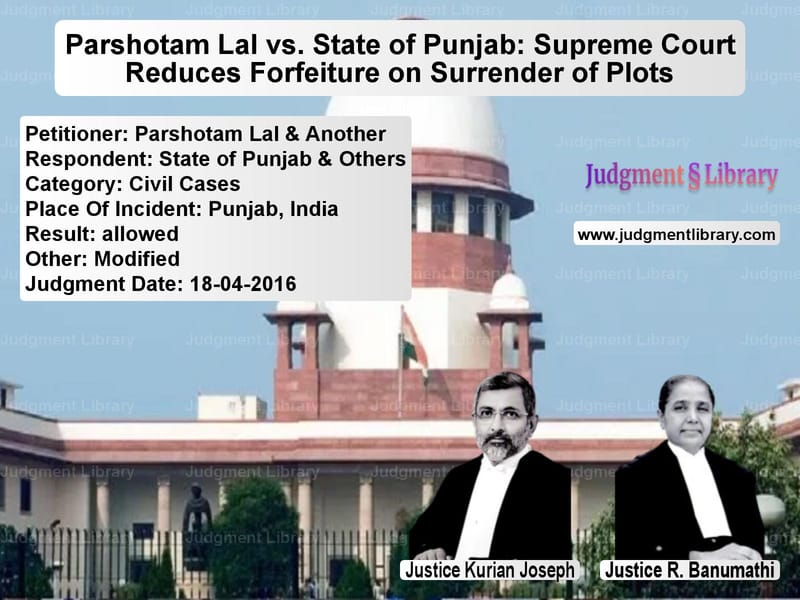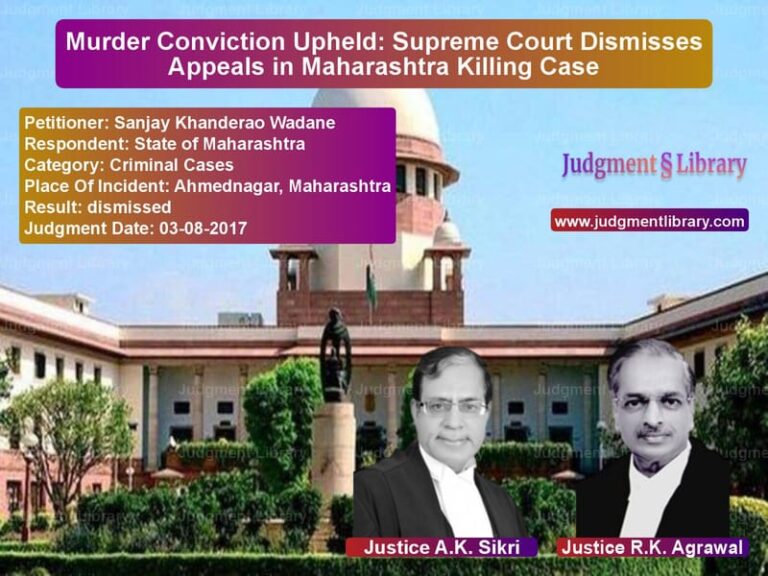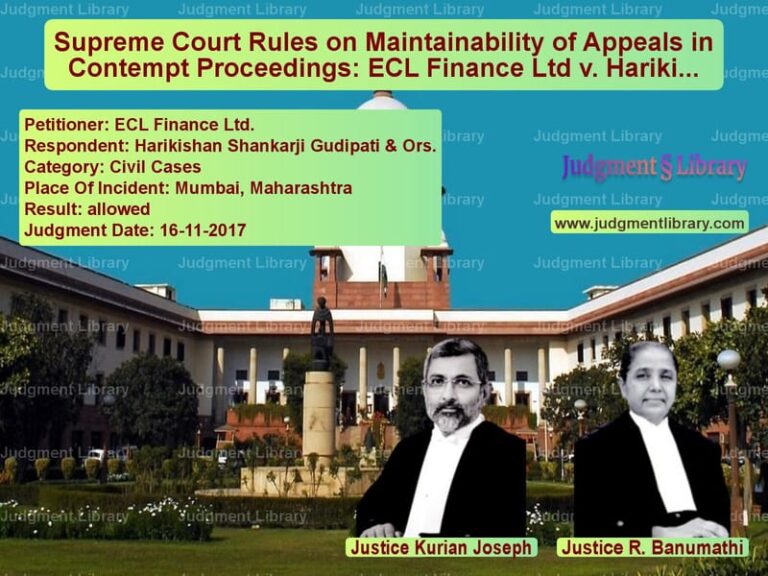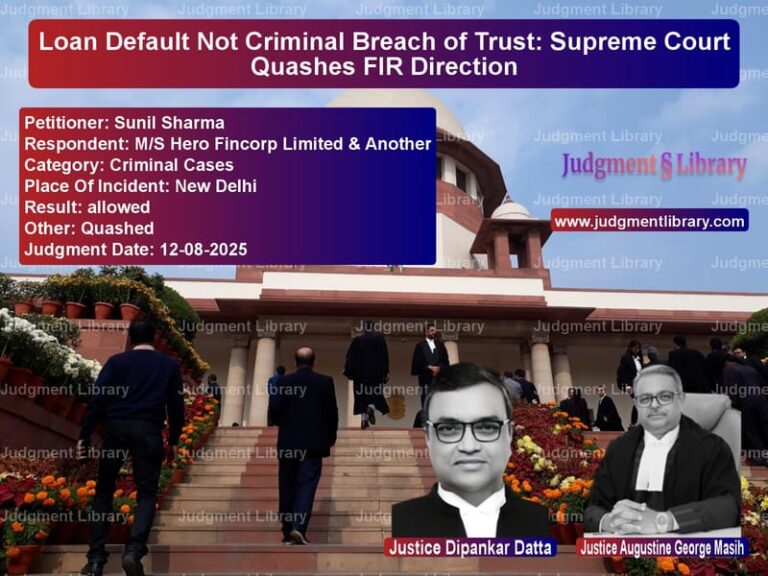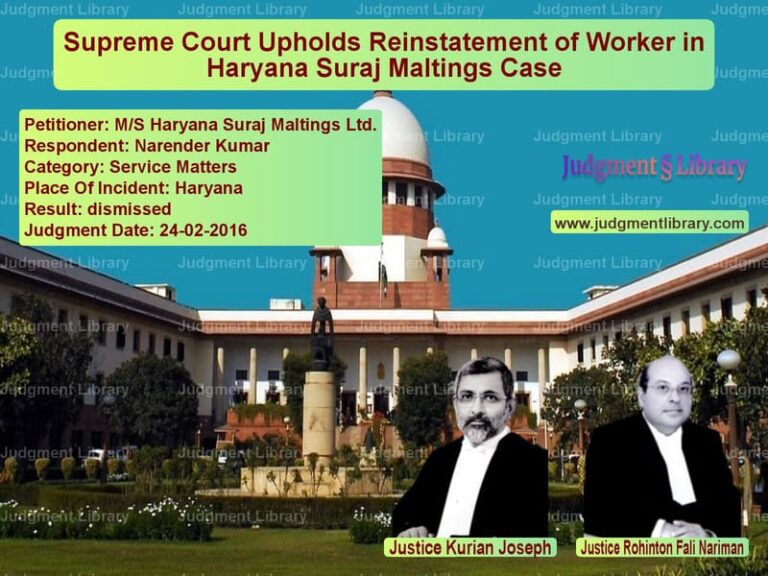Parshotam Lal vs. State of Punjab: Supreme Court Reduces Forfeiture on Surrender of Plots
The Supreme Court of India, in its judgment dated April 18, 2016, delivered a crucial ruling in the case of Parshotam Lal & Another vs. State of Punjab & Others. The case revolved around the discretion exercised by the Revisional/Appellate Authority regarding the percentage of forfeiture on the surrender of plots. The appellants had challenged the non-uniform approach in determining forfeiture percentages, arguing that they should be granted similar treatment to previous cases.
Background of the Case
The appellants, Parshotam Lal and another, had surrendered plots and were subject to forfeiture. They contested the percentage of forfeiture imposed on them, claiming that similar cases had been granted more favorable terms. The Supreme Court examined whether the discretion exercised by the authorities in imposing forfeiture percentages was uniform and whether the appellants were entitled to a reduction in forfeiture.
Legal Issues Raised
The key legal question in this case was whether the forfeiture percentage imposed on the appellants was justified and whether they should be granted similar treatment to other cases where a lower percentage had been applied.
Arguments by the Petitioner (Appellant)
- The appellants argued that there was no uniform approach in determining the percentage of forfeiture imposed on surrendered plots.
- They contended that in similar cases, such as those mentioned in Annexure P6, a lower forfeiture percentage had been applied, and they should be treated in the same manner.
- The appellants claimed that the authorities had exercised discretion arbitrarily, leading to an unfair outcome.
- They requested the court to direct the authorities to apply a uniform standard to all similar cases.
Arguments by the Respondent
- The respondents argued that there could not be a uniform standard for forfeiture as the factual circumstances varied from case to case.
- They contended that the percentage of forfeiture depended on the specific facts and conditions applicable to each plot surrender.
- The respondents asserted that the forfeiture process was carried out in accordance with the statutory provisions and that the appellants had no grounds to challenge the decision.
Supreme Court’s Observations
The Supreme Court took note of the arguments presented by both parties and made the following key observations:
- The court acknowledged that the authorities had exercised discretion in imposing forfeiture but noted that there was a lack of consistency in determining the percentage.
- It agreed with the respondents that different cases might have different factual circumstances, which could impact the percentage of forfeiture.
- However, given the specific facts of this case, the court deemed it appropriate to grant the appellants similar treatment to the cases mentioned in Annexure P6.
Supreme Court’s Ruling
The Supreme Court ruled in favor of the appellants and issued the following directions:
- The percentage of forfeiture imposed on the appellants was reduced to 2%.
- The court clarified that this decision was based on the peculiar facts and circumstances of the case and should not be treated as a precedent for future cases.
- The appeal was allowed, and no costs were imposed.
Analysis of the Judgment
The Supreme Court’s decision in Parshotam Lal vs. State of Punjab highlights the importance of fairness in administrative decision-making. The key takeaways from the ruling include:
- Need for Uniformity: The judgment underscores the necessity for consistency in determining forfeiture percentages. While discretion may be exercised, similar cases should be treated in a comparable manner.
- Judicial Intervention in Administrative Decisions: The ruling demonstrates the court’s willingness to intervene when administrative decisions appear to lack uniformity and fairness.
- Limited Scope of Precedent: The Supreme Court explicitly stated that this decision was based on the unique facts of the case and should not be used as a binding precedent for other forfeiture disputes.
Implications of the Judgment
The ruling has several implications for future cases involving forfeiture on surrendered plots:
- Guidance for Authorities: Authorities must exercise their discretion consistently and ensure that similar cases are treated equitably.
- Potential for Future Challenges: While the court stated that this ruling should not be treated as a precedent, it may encourage other litigants to challenge forfeiture decisions on similar grounds.
- Reinforcement of Judicial Oversight: The case reaffirms that courts can intervene in administrative matters when there is evidence of arbitrary decision-making.
Conclusion
The Supreme Court’s judgment in Parshotam Lal vs. State of Punjab is a significant ruling that addresses the issue of discretionary decision-making by authorities in forfeiture cases. By reducing the forfeiture percentage for the appellants, the court ensured that they received fair treatment in line with similar cases. The ruling reinforces the principles of equity and fairness in administrative law while acknowledging that each case must be evaluated on its own merits.
Don’t miss out on the full details! Download the complete judgment in PDF format below and gain valuable insights instantly!
Download Judgment: Parshotam Lal & Anot vs State of Punjab & Ot Supreme Court of India Judgment Dated 18-04-2016-1741854666964.pdf
Direct Downlaod Judgment: Direct downlaod this Judgment
See all petitions in Property Disputes
See all petitions in Contract Disputes
See all petitions in Damages and Compensation
See all petitions in Judgment by Kurian Joseph
See all petitions in Judgment by R. Banumathi
See all petitions in allowed
See all petitions in Modified
See all petitions in supreme court of India judgments April 2016
See all petitions in 2016 judgments
See all posts in Civil Cases Category
See all allowed petitions in Civil Cases Category
See all Dismissed petitions in Civil Cases Category
See all partially allowed petitions in Civil Cases Category

